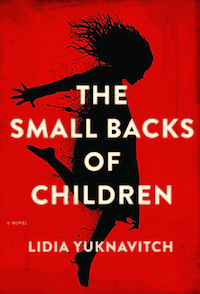
“The personal is political”—a phrase made famous in the 1960s by radical feminist Carol Hanisch’s essay of the same name—means, among other things, that when people openly share narratives about their intimate lives (marriage, abortion, sexuality, abuse) it is more than catharsis; it’s a political act. Diverse stories, sometimes grim and graphic, are as politically necessary as traditional political actions such as protests. At its best, the consciousness-raising act of storytelling can radically change a cultural conversation by forcing people to listen to experiences they could otherwise easily ignore.
The idea that writing can be a political act is important to keep in mind when reading Lidia Yuknavitch. A longtime advocate for experimental literature and for those writing from the margins, Yuknavitch is on the publishing board of FC2 and co-founder of Chiasmus Press, a feminist indie press in the Pacific Northwest. She has said, “I’m still going to jam my foot in the open door so that any body can get through and try, especially the bodies ordinarily locked out.” So, politics. She’s into them.
In Yuknavitch’s oeuvre you get a sense that she’s writing toward a great purpose, toward a revolution. The Small Backs of Children is no different. Even though it’s a novel, it tackles wildly personal issues: motherhood, stillbirths, sexuality, war, sadomasochism, addiction. Many of these issues appear in her autobiographical writing as well. The pervasiveness of Yuknavitch’s politics in her work is profound. But this time she is again holding the door open for a different kind of literary character.
Yuknavitch approaches her characters’ humanity in a way that veers left before traditional storytelling and makes its own road. Sometimes this road takes you to the garage of a painter where he is fingering his own asshole, high out of his mind and masturbating on the floor before covering himself in turpentine and cum, then completing his painting. Sometimes it takes you to a beach at night where a mother has stolen her dead baby from the hospital so she can cremate it herself on a moonlit beach. She lights the infant’s lifeless body on fire with matches, clumps of her own hair, and bits of sage. She watches her daughter burn.
The plot of this novel is not simple. It alternates narrators, switches between place and time, and changes countries with little warning. These movements give a dreamlike quality to the book, which progresses in slim chapters, toggling between an orphan girl in Europe and a group of American artists called solely by their crafts: the writer, the filmmaker, the photographer, the poet, the performance artist, the painter, and the playwright. They are all linked by a picture taken of the orphan girl and made famous by the photographer while she was on assignment to document a war in an Eastern European village ravaged by violence. The photograph of the girl, blown toward the camera’s lens as a bomb explodes behind her, her expression crystalized in a perfect moment of fear, becomes famous. But the image has debilitating consequences for the writer. The writer’s fascination with the orphan girl’s photograph sends her into a suicidal coma, and she is hospitalized.
Hoping to save their friend, the artists journey to Eastern Europe in search of the lost girl. They want to bring her to America, thinking that perhaps the girl’s real presence, resurrected from the ephemera of image, will be enough to shake the writer from her depression and reawaken her. What follows is a clash of cultures and an exploration of the boundaries between sex and violence, art and obsession.
The artist characters see the world refracted through their specific mediums. They have arranged their lives, messily at times, so they can pursue the pure representation in art. Just as the girl becomes fodder for the photographer’s portfolio, the artists use each other—violently, sexually, and completely—in a quest for their own success.
Here is the playwright in the hospital waiting for news about his sister, the writer:
The playwright stops typing for a second and stares at his hands on his laptop. He can’t believe he’s already writing this. Already twisting it into art. Cannibal. He feels a pang of guilt. You’re in a hospital. Your sister is dying.
His guilt doesn’t last long. He continues to document the moment. “Anyway,” he thinks to himself, “She’d be on his side. Wouldn’t she?” Meaning, she’d use this, too. It’s possible the writer would agree. Maybe she would cheer his drive to twist her into art. After all, this is what Yuknavitch appears to be doing.
Another quality that links Yuknavitch’s previous writing to The Small Backs of Children is the distinct narrative voice, which so capably renders the intimacy between her characters. Yuknavitch uses language in a way that is so sensual it is almost sexual:
In the not-American night she is partly her poet self and partly her id. Most of the time she’s either in her mind or in her body—thinking or acting. A pounding between her legs… She has been given the address to a place where a woman might mouth the mouths of other women. What she wants first is to watch. To watch two women, not American, bring themselves to the brink of animal. The cum, the piss, the shit. Blood and sweat and mouths and salt. Skin reddened or scraped or bleeding or bitten or bruised. Shoved. That violence… If the scene fails, the writing will.
Yuknavitch’s voice is like the love child of Kathy Acker, Jean Rhys, and Carole Maso. Her fierce verbal affronts, filled with invented words and portmanteaus, not only bring meta-fiction into the writing, it also creates the subversive sound bites that give her writing its unique contour. This is the Lidia stamp.
Yuknavtich covers a lot in a rather slim novel, and she does a fine job of propelling the reader further into the text with action. But large jumps between scenes and unlikely conveniences in the plot seem like cut corners instead of inevitable turns in the story. The end rushes quickly toward a conclusion, before I, as a reader, feel it has concluded. The bodily language and odd evocative descriptions did more to fasten me to the book than the plot, which seemed at times to slip away from itself too soon.
Whether Yuknavitch set out to write a revolution, I can’t say. What I can say is that she undermines traditional story culture by seeking out moments so personal or uncouth they would normally not make it into mainstream novels. To me this is a political action, and an important one. In The Small Backs of Children these graphic, intense details usually deal with the body, but sometimes they also deal with the heart. Yuknavitch has succeeded in fulfilling E.L. Doctorow’s charge: “The reason we need writers, is because we need witnesses.” The Small Backs of Children proves once again that Yuknavitch is witness to the kind of stories we ought to read.





